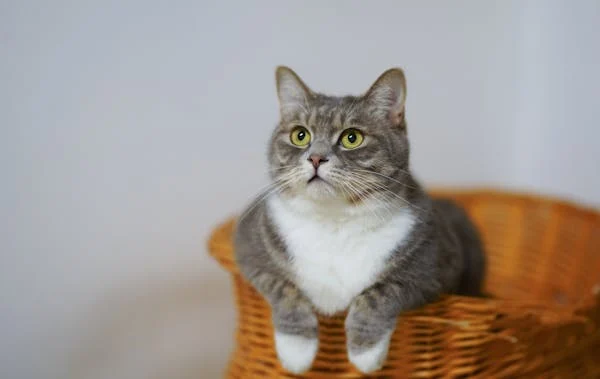Cats, with their sleek and mysterious movements, often leave us wondering what they’re thinking. Unlike dogs, whose body language may be more overt and expressive, cats communicate subtly through a mix of physical cues and vocalizations. Deciphering a cat’s body language can help you better understand their moods, desires, and overall well-being. Here’s a guide to what your cat might be telling you through their movements, posture, and expressions.
1. Tail Talk
A cat’s tail is one of the most expressive parts of its body. Paying attention to its position and movement can reveal a lot about how your cat is feeling.
- Tail Up, Slight Curve at the Tip: A confident and friendly cat will often hold its tail upright with a gentle curve. This posture shows that your cat is comfortable and content. If they approach you with their tail high, it’s a greeting or invitation for interaction.
- Puffed Tail: A puffed-up tail is a clear sign that your cat is frightened or startled. In this state, your cat is trying to make itself look bigger and more intimidating. Proceed with caution or give your cat space to calm down.
- Tail Twitching or Flicking: A tail that flicks quickly back and forth often indicates agitation, frustration, or excitement. If you’re petting your cat and the tail starts twitching, it might be a signal to stop before they get too irritated.
- Tail Wrapped Around the Body: A cat that tucks its tail around its body, particularly when sitting, may be feeling anxious or uncertain. It’s a protective stance that shows they’re not feeling fully secure.
2. Eyes: The Windows to the Feline Soul
Cats use their eyes to convey a range of emotions, from love to aggression.
- Slow Blinking: If your cat slowly blinks at you, it’s a sign of trust and affection. Cats rarely blink at perceived threats, so slow blinking is often called a “cat kiss.” You can reciprocate by blinking back slowly to show your love.
- Wide Pupils: Dilated pupils can indicate excitement, fear, or even aggression, depending on the context. For example, a cat preparing to pounce in play might have large, dilated pupils. However, if they’re wide-eyed and retreating, your cat might be scared.
- Narrow, Slitted Eyes: When a cat’s pupils narrow into slits, it usually means they’re feeling annoyed, aggressive, or on high alert. However, it can also occur when a cat is in bright light, so context is important.
3. Ear Positions
Cats have highly mobile ears, and their position can provide key insights into your cat’s emotional state.
- Ears Forward: When a cat’s ears are pointing forward, they are alert, curious, or playful. This is generally a positive sign, especially when paired with a relaxed body and bright eyes.
- Ears Flattened (Airplane Ears): Flattened ears are a sign of fear, stress, or aggression. If your cat’s ears are pinned back against its head, it’s best to give them space, as they might feel threatened and could lash out.
- Ears Swiveling: Cats can swivel their ears independently to track sounds. If your cat’s ears are constantly moving, they’re probably focused on something happening around them and could be in a heightened state of alertness.
4. Whiskers and Nose
Whiskers are highly sensitive and contribute to a cat’s body language.
- Whiskers Forward: When a cat is interested or curious about something, their whiskers will push forward. You’ll often see this when they’re focused on hunting or exploring.
- Whiskers Pulled Back: Whiskers that are pulled flat against the face often signal fear or discomfort. Cats instinctively draw their whiskers in when they feel threatened.
- Sniffing or Nuzzling: Cats may sniff or nuzzle as a sign of affection, exploration, or marking territory. When a cat nuzzles you, they’re often transferring pheromones to create a sense of familiarity and bonding.
5. Posture and Overall Body Language
A cat’s stance or how they carry their body can reveal a lot about how they’re feeling.
- Arched Back: A cat with an arched back, raised fur, and a puffed tail is frightened or trying to appear intimidating. They may hiss or growl in this stance. However, a gentle arch while being petted can also indicate that your cat is enjoying the touch.
- Lying on Back, Belly Exposed: When a cat rolls onto its back and exposes its belly, it can be a sign of trust and comfort. However, this is not always an invitation for belly rubs. Many cats dislike being touched on the belly, even when they’re feeling safe.
- Crouching, Tense Body: A crouched posture with tense muscles can indicate fear, stress, or uncertainty. In this state, your cat may be preparing to flee or defend itself if necessary.
- Rubbing Against You: When a cat rubs its body against you, they are marking you with their scent as a way of showing affection and claiming you as part of their territory.
6. Vocal Cues Paired with Body Language
While this article focuses on body language, vocalizations are often paired with movements to communicate even more clearly.
- Purring: Purring is often a sign of contentment, but it can also occur when a cat is in pain or anxious. Look at your cat’s overall body language to determine whether they’re purring from happiness or stress.
- Hissing or Growling: These vocalizations are clear warnings that your cat is feeling threatened or upset. Combine this with a defensive posture (arched back, flattened ears) to understand that it’s time to give your cat some space.
Conclusion
Understanding your cat’s body language is key to building a strong bond and providing a happy, stress-free environment for your feline friend. By observing their tail, eyes, ears, and overall posture, you’ll be able to interpret their moods and meet their needs more effectively. Over time, you’ll become more attuned to your cat’s unique ways of communicating, leading to a deeper, more fulfilling relationship.

